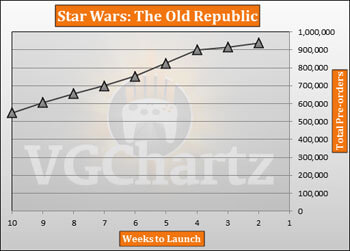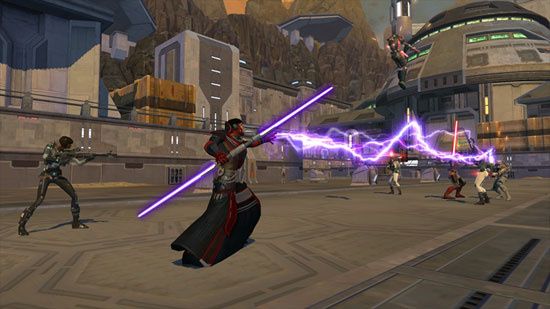
Star Wars: The Old Republic immerses players in a universe that's an even longer time ago as it occurs thousands of years before A New Hope.
On December 20, 2011, a new chapter in the Star Wars universe was unleashed on the world. After 5 years in development at a cost estimated at around $200 million, Bioware, in partnership with Electronic Arts and LucasArts, launched its first massive multiplayer online (MMO) game, Star Wars: The Old Republic (SWTOR). Venturing into one of the most valuable intellectual properties in the world, Bioware took an enormous gamble. Internet chatter, which once lauded the game as the one MMO that could end World of Warcraft‘s reign, started raising concerns of a flop as the launch date came and went. Still, reviews for the game were some of the highest for any MMO ever, even more than Star Wars Galaxies, which Sony released in 2003. But was the gaming world ready for yet another subscription-based Star Wars MMO?
The answer is a resounding yes, at least for now. Electronic Arts recently reported that 2 million copies of the game have sold and 1.7 million players have subscribed, signaling strong player retention for MMO players who are notoriously migratory. (Cue your favorite line from the movies here, such as “The force is strong in this one,” “Now this is podracing,” or “Do or do not – there is no try.”)

SWTOR preorders neared the 1 million mark days before its release and continued to sell copies after launch.
True, there have been some technical hiccups, including the Early Access fiasco, multi-hour wait times at launch, imbalance in the player-vs-player part of the game, and some rather serious exploits, some funny (/getdown should be a meme) and some making players incredibly wealthy. Yet, Bioware has handled these issues like a pro and squashed the bugs rapidly and conclusively. In other words, the game has had an incredibly successful launch. Furthermore, Bioware has already released its first update to the game and announced the release of a major update slated for March, which will bring new content, game systems, and improvements in the player-vs-player experience.
But now that the hype has settled down, it’s time to put the game into a broader perspective and ask, how innovative is SWTOR?
‘Innovation’ in the video game world is often just a PR term used for marketing. Players, however, gauge innovation by how different it is from other games and how much those differences enhance the fun. Because of the millions of dollars on the line, most games that are part of a franchise don’t try to rock the boat too much lest they go against player expectations from previous experiences. The safe approach is to give gamers more of what made prior games successful, update/improve the graphics, and perhaps push the story into new, but relatively comfortable places. The Bioware developers could have gone this route with SWTOR. However, they did make it clear that they wanted to make an innovative game, one that could compete with the big hitters in the MMO space and live up to what players expect when they imagine running a character around the Star Wars universe, noobs and fanboys alike.
Although some parts of the game are very much like other MMOs, Bioware made it clear that SWTOR would be the first story-based MMO, and the story lines receive some of the highest praises from players and critics alike. For the sake of immersion, thousands of voice actors were utilized to immerse players into the universe, rather than forcing them to read blocks of text to pick up a quest. Bioware also employed its homegrown “choose-your-own-adventure-esque” choice system that provides players with a decision tree when interacting with non-players characters, used in the popular Mass Effect games. Furthermore, players can make decisions that change their force alignment towards the light or dark sides of the force. Instead of solo players having to traverse planet-to-planet completely alone, each player has a crew that can craft or assist in questing. And while at times it has been criticized for such, it effectively hybridizes the best of the single-player game genre with a “true” MMO, which allows SWTOR to avoid some of the pitfalls associated with other games in its genre, such as endgame overemphasis, all-night raids, gear grinds, and so on. Finally, one of the best measures of an innovation is whether it can achieve that quantum-leap-like change, in which its hard to imagine going back to the way things were before. Indeed, the SWTOR forums are peppered with testimonies from players echoing this sentiment.
But why is Bioware being judged on whether it’s produced a truly innovative game?
The answer is that from the beginning, innovation and Star Wars have gone hand in hand. That was true when George Lucas made the original trilogy and the prequels. It’s been true of The Clone Wars animated TV series as well as every iteration of Star Wars video game ever made (and there are many). The merchandising campaign that has evolved throughout the years is also groundbreaking. And of course, the Star Wars universe itself is a testament to technological innovation, from the light saber to the hyperdrive, and this technology has served to inspire technology in real life. In fact, one of the enduring legacies of the Star Wars franchise is the way that it immerses us into a future time, allowing us to try to imagine how life would be in that world. The best science fiction, including Star Trek which also has its own MMO, don’t merely provide a view of what the future could be — they define what they should be.
In a nutshell, SWTOR allows us to envision a potential post-singularity world and imagine finding our way in it, much like the old 1950′s cartoons that tried to depict what the future would look like.
SWTOR has a long way to go before it can be deemed a success in the long term (translate that as ‘profitable’). In fact, Bioware has stated that for the game to break even in addition to supporting the release of content updates every 2 months, it needs to maintain 500,000 subscribers. Coupled with this, the costs of updates is likely to be significantly higher than regular MMOs because of the voice acting. So gamers and investors both will be watching over the course of 2012 for any signs that the SWTOR player community starts dwindling significantly.
As long as Bioware continues to deliver a high-quality experience, SWTOR should have a long lifespan and just maybe, it will inspire yet another generation of young scientists and engineers to bring the technology of the future into today.
Check out this video from Bioware’s development team showcasing the story and decision tree in the Black Talon flashpoint:
[Media: Bioware, VGChartz]
[Sources: Bioware, CNN, Eurogamer, Gamespot, Massively, Reuters]



